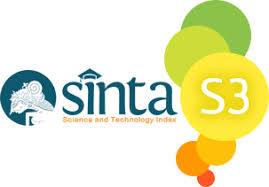Analisis resepsi khalayak terhadap pemberitaan Covid-19 di klikdokter.com
 Abstract views: 5756
,
Abstract views: 5756
,
 PDF downloads: 6675
PDF downloads: 6675
Abstract
One of the health problems that will catch people's attention in 2020 is COVID-19. Various media also highlighted the problem because it was considered a dangerous thing. One of the media that participated in the news was a health media called Klikdokter.com. Klikdokter.com has been intensively reporting about COVID-19 since January 2020. The aim of the research is to see how the public perception about COVID-19 on Klikdokter.com. This research uses descriptive qualitative research. Methods of data collection using observation, interviews, and documentation. Meanwhile, informants were selected based on purposive sampling. The data analysis used Stuart Hall's Encoding-Decoding theory, which describes the three positions of the audience in constructing messages, namely dominant position, negotiation, and opposition. The results showed that the position of the audience in constructing messages from the news of COVID-19 on Klikdokter.com, the majority were in a negotiating position. This position means that the audience may misinterpret some parts of the message and quite understand what is conveyed by Klikdokter.com.
Keywords: Covid-19; Reception; Reporting.
References
Baran, S. J., & Davis, D. K. (2010). Teori komunikasi massa: Dasar, pergolakan, dan masa depan. Jakarta: Salemba Humanika.
Basilaia, G., & Kvavadze, D. (2020). Transition to Online Education in Schools during a SARS-CoV-2 Coronavirus (COVID-19) Pandemic in Georgia. Pedagogical Research. https://doi.org/10.29333/pr/7937
Bungin, B. (2007). Penelitian kualitatif: komunikasi, ekonomi, kebijakan publik, dan ilmu sosial lainnya (Vol. 2). Kencana.
Creswell, J. W. (2014). Penelitian Kualitatif & Desain Riset. Pustaka Pelajar.
Hadi, I. P. (2008). Penelitian khalayak dalam perspektif reception analysis. Scriptura, 3(1), 1–7.
Hall, S., Hobson, D., Lowe, A., & Willis, P. (2011). Budaya Media Bahasa: Teks Utama Pencanang Cultural Studies 1972-1979. Yogyakarta: Jalasutra.
Kriyantono, R. (2009). Public Relations Writing; Media Public Relations, Membangun Citra Korporat. Kencana.
McQuail, D. (2011). Teori Komunikasi Massa, Edisi 6 Buku 1. Jakarta: Salemba Humanika.
Mulyana, D. (2013). Metodologi Penelitian Kualitatif (Issue Bandung: PT Remaja Rosdakarya).
Panuju, R., Susilo, D., & Sugihartati, R. (2018). A Strategy for Competitive Broadcasting - Radio Community Networking in Tulungagung, Indonesia. https://doi.org/10.5220/0007331504670472
Petropoulos, F., & Makridakis, S. (2020). Forecasting the novel coronavirus COVID-19. PLoS ONE, 15((3): e02). https://doi.org/https://doi.org/10.1371/journal.pone.0231236
Susilo, D. (2020). Penitipan Handphone Sebagai Komunikasi Non Verbal Santri PPP Walisongo Desa Cukir Jombang. Communication, 11(1), 94–111.
Susilo, D., & Akbar, W. (2020). Economic development on society : Decision to keep driving on ride- sharing transportation in Indonesia. Revista, 41(10), 17.
Ting, D., Carin, L., Dzau, V., & Wong, T. (2020). Digital technology and COVID-19. Nature Medicine, 1–3.
Copyright (c) 2021 Jurnal Komunikasi Profesional

This work is licensed under a Creative Commons Attribution-ShareAlike 4.0 International License.

Jurnal Komunikasi Profesional is licensed under a Creative Commons Attribution-ShareAlike 4.0 International License.
1. Proposed Policy for Journals That Offer Open Access
Authors who publish with this journal agree to the following terms:
- Authors retain copyright and grant the journal right of first publication with the work simultaneously licensed under a Creative Commons Attribution License that allows others to share the work with an acknowledgment of the work's authorship and initial publication in this journal.
- Authors are able to enter into separate, additional contractual arrangements for the non-exclusive distribution of the journal's published version of the work (e.g., post it to an institutional repository or publish it in a book), with an acknowledgement of its initial publication in this journal.
- Authors are permitted and encouraged to post their work online (e.g., in institutional repositories or on their website) prior to and during the submission process, as it can lead to productive exchanges, as well as earlier and greater citation of published work (See The Effect of Open Access).
2. Proposed Policy for Journals That Offer Delayed Open Access
Authors who publish with this journal agree to the following terms:
- Authors retain copyright and grant the journal right of first publication, with the work [SPECIFY PERIOD OF TIME] after publication simultaneously licensed under a Creative Commons Attribution License that allows others to share the work with an acknowledgement of the work's authorship and initial publication in this journal.
- Authors are able to enter into separate, additional contractual arrangements for the non-exclusive distribution of the journal's published version of the work (e.g., post it to an institutional repository or publish it in a book), with an acknowledgement of its initial publication in this journal.
- Authors are permitted and encouraged to post their work online (e.g., in institutional repositories or on their website) prior to and during the submission process, as it can lead to productive exchanges, as well as earlier and greater citation of published work (See The Effect of Open Access).



